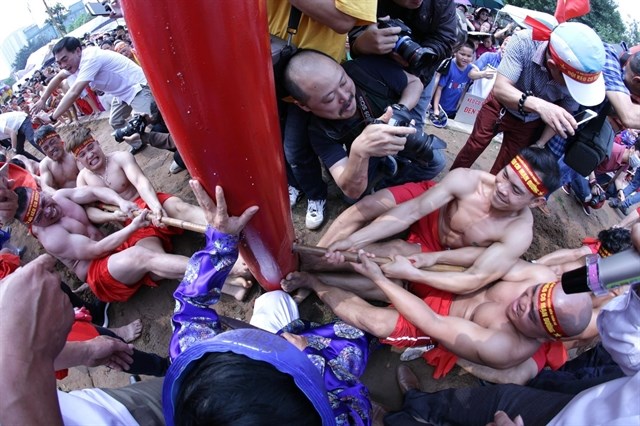
An ancient form of tug of war is still organised at the Tran Vu Temple Festival on the third day of the third lunar month in Thach Ban ward, Long Bien district, Hanoi.

Two competing teams pull some bamboo, which runs through a hole on
a big wooden pillar. The pillar stands firmly on the ground. The athletes lean
their feet against wooden pillar to have more power to pull the bamboo back
toward their team's side. (Photo: VNA)
Legend has it that during a serious drought, only one of 12 wells
in Ngọc Tri village still contained water.
Men from Cho hamlet went to collect water from the well but were stopped by men
from Dia hamlet. At that time they used bamboo twine to carry the water home.
When a fight for the precious resource broke out, both sides were afraid of
spilling the water, so they sat down and battled to pull the water from each
other, some even clinging on to the buckets for dear life.
When the drought was over, elders in the village initiated the game as a
reflection of the fight at the village festival in order to wish for a better
weather, a bumper crop and a prosperous life.
The event has been recognised as an Intangible Cultural Heritage of Humanity by
UNESCO.
The festival at Tran Vu Temple includes a ceremony and the tug of war to
express locals’ respect for the gods and their desire for a peaceful life.
Source: VNA
With an increasingly vibrant and widespread emulation movement aimed at building cultured residential areas and cultured families, Yen Thuy District has been making steady progress toward improving both the material and spiritual well-being of its people, while fostering a civilized, prosperous, beautiful, and progressive community.
Once lacking recreational spaces and community facilities, Residential Group 2 in Quynh Lam Ward (Hoa Binh City) has recently received attention for the construction of a new, spacious, and fully equipped cultural house. The project followed the model of state support combined with public contributions in both labor and funding.
The "All people unite to build cultural life" movement, which has been effectively integrated with Kim Boi district’s socio-economic development goals, is fostering a lively spirit of emulation across local residential areas, hamlets, villages, public agencies, and enterprises. In addition, through the initiative, traditional cultural values are being preserved and promoted, while community solidarity and mutual support in poverty reduction and economic development are being strengthened.
A working delegation of the Hoa Binh provincial People’s Committee led by its Permanent Vice Chairman Nguyen Van Toan on June 11 inspected the progress of a project to build the Mo Muong Cultural Heritage Conservation Space linked to tourism services in Hop Phong commune, Cao Phong district.
Born and growing in the heroic land of Muong Dong, Dinh Thi Kieu Dung, a resident in Bo town of Kim Boi district, in her childhood was nurtured by the sweet lullabies of her grandmother and mother. These melodies deeply imprinted on her soul, becoming an inseparable part of her love for her ethnic group's culture. For over 20 years, this love for her hometown has driven Dung to research, collect, and pass down the cultural values of the Muong people to future generations.
In the final days of May, the Ethnic Art Troupe of Hoa Binh Province organized performances to serve the people in remote, mountainous, and particularly disadvantaged areas within the province. These were not just ordinary artistic shows, but they were the meaningful journeys aimed at spreading cultural values, enhancing the spiritual life of the people and contributing to the preservation of ethnic minority cultural identities.



